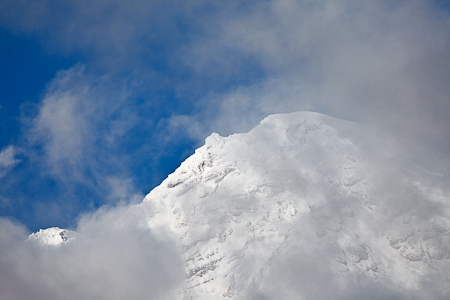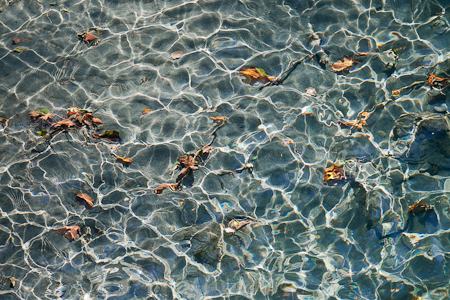 Bright, intelligent eyes are characteristic of foxes; this individual’s distinct grizzled black and gray color combination marks it as a Silver Fox
Bright, intelligent eyes are characteristic of foxes; this individual’s distinct grizzled black and gray color combination marks it as a Silver Fox
The nearly black Silver Fox sat atop the fresh snow, peering down intently with its ears and eyes focused on a nearby spot under the snow. We watched for several minutes, and I told Karen I would like to continue watching, because something was going to happen. Suddenly the fox leaped high into the air, kicked its legs up and dove face first down into the snow. It apparently pinned the mouse it was after, using its paws, then ate it. The fox came up licking its chops, then sauntered into the forest.



 The sequence of a fox naturally hunting a mouse under the snow, described above
The sequence of a fox naturally hunting a mouse under the snow, described above
This fox, a high mountain subspecies known to scientists as the Cascade Red Fox (Vulpes vulpes cascadensis), lives in the high country of Oregon, Washington, and British Columbia. It has always been considered secretive and has been seldom seen by hikers and park visitors. That is, until recently.
Our Silver Fox was mousing among the cabins at Longmire, a settlement of National Park Service staff and lodge visitors on the road to Paradise. Nearby, a second Red Fox with the reddish-orange coloration more typical of the species, sat lazily in the sun. I watched it from about 20 feet away, as it woke up from its sleepiness, yawned, and stretched, before trotting off to work.
 A second Red Fox, this one with more typical coloration, luxuriates in the weak winter sun
A second Red Fox, this one with more typical coloration, luxuriates in the weak winter sun
 Yawning and stretching before getting back to work
Yawning and stretching before getting back to work
And work turned out to be scavenging in the parking lots of Longmire for cracker crumbs, spilled drinks, and whatever other human food was offered. Begging and scavenging was certainly easier than hunting for rodents.
Recent visitors to Mount Rainier now see Red Foxes routinely at Longmire, Paradise, and even as high as the climbers’ shelter at Camp Muir, high on the snowy mountain. The foxes appear to have quickly adapted to human visitors; I didn’t see foxes routinely on visits to Mount Rainier National Park until two years ago. Now I see one or more on nearly every trip.
 This fox’s “work” consists of trotting around the parking lot at Longmire, looking for spilled food
This fox’s “work” consists of trotting around the parking lot at Longmire, looking for spilled food
 And if it gets really lucky, a foolish visitor may feed it from outstretched fingers
And if it gets really lucky, a foolish visitor may feed it from outstretched fingers
I love seeing the foxes. Other visitors love seeing the foxes. The irony I see is that the thrill of seeing these foxes is a direct result of activity–people feeding them–that is unwise, against park policy, and will result in a fox nipping a visitor, followed by the Park Service having to kill the fox and test it for rabies. So, despite the fun of seeing the foxes, it would be better if most of us did not routinely see them, because all the scavenging and begging will be the death of foxes. Sad but true. Though the bad behavior by others did allow me to get these pictures, which ends up being a guilty pleasure. So be it.
The park’s dilemma is how to keep people from feeding the foxes, much as they have had to keep people from feeding the bears and raccoons in many parks. I saw no signs warning visitors about feeding the foxes, but there has been a recent press release from the National Park Service warning that it is illegal to feed the foxes. I expect stronger enforcement from now on.
The Cascade Fox itself is fascinating. It seems that about half the individuals I’ve seen are the very dark Silver Fox, and about half are the more typical red color. These color variants occur in the same litter, and they are not different types of foxes.
 These are truly magnificent animals
These are truly magnificent animals
The Cascade Fox is a native of these high mountains, and does not occur in the lowlands. There are Red Foxes in the lowlands, and these were not native to the region and are genetically different. These foxes were introduced to the Puget Sound lowlands, some intentionally and some as escapees from fur farms. Now they are widespread, and I have seen them near my home. These two subspecies do not normally interbreed, as their habitats are so different and the vast forested foothills act as a barrier between them.
The photographs in this set represent two foxes who engaged in their natural behavior and in their unfortunate interaction with humans. I felt privileged to spend some time with them (and, no, I did not feed them!).
 Snowy Mount Rainier suddenly revealed by parting clouds
Snowy Mount Rainier suddenly revealed by parting clouds
 Snowy conifer forest along the Wonderland Trail near Longmire
Snowy conifer forest along the Wonderland Trail near Longmire
 The Nisqually River descending The Mountain from the Nisqually Glacier
The Nisqually River descending The Mountain from the Nisqually Glacier
 Snow falling off trees went straight down my back!
Snow falling off trees went straight down my back!
Go to LeeRentz.com to view the range of work by Lee Rentz. Work is available as metal or archival paper prints, and most are available for licensing for websites, magazines, and books.


























